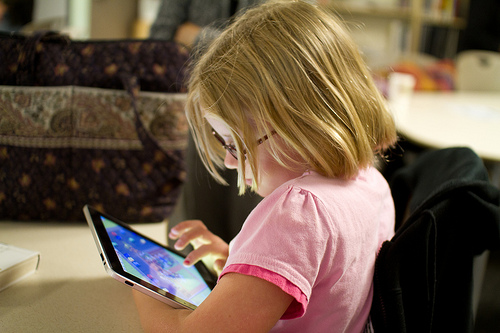
The Sitka School District envisions tablets for students in the elementary grades, and laptops for older students. (Flickr photo/Devon Christopher Adams}
The board held a presentation on the Alaska 1:1 Digital Learning Initiative Tuesday night (2-18-14).
The presentation evolved into a free-wheeling discussion of the role of technology in all our lives, and whether it contributes to real learning, or creates shortcuts that may ultimately weaken education.
See KCAW’s previous reporting on the Digital Learning Initiative.
The presentation itself was mostly technical: how much bandwidth would the Sitka School District require if every student were online, how many devices would be needed, what kind, how much teacher training would be needed, and how many more IT staff would the district need to make everything work.
District IT director Ian Crane had been researching all those questions with other districts. But the feedback he’d been receiving wasn’t necessarily all technical. Students take a lot better care of tablets or computers when they belong to them. Also…
“Disciplinary action, especially off-time, outside of the classroom, apparently goes down astronomically because they’re not bored in the hallways. They have things they can do on their device. That was an unforseen benefit. It changes a lot of dynamics within a school district.”
The district is just beginning to build its budget for the next school year, and whether it can join the 1:1 initiative is far from certain. Training teachers in the new Common-Core based standards, buying materials, and developing new assessment methods — all have significant costs, and all likely have a higher priority for the coming year.
So as cool as it sounds to put a tablet or laptop in the hands of every student, it might just be wishful thinking at this moment in the budget cycle.
And even if the money were there, is there still wishful thinking around the expectations for technology?
Audience member Dorik Mechau is a senior fellow of Sitka’s Island Institute and a former director of the Alaska Humanities Forum. He did not see any malice in the school board’s desire to pursue the 1:1 Initiative, and he did not see an intention to exclude other teaching methodologies.
He wondered if technology was really the right path.
“When I see youngsters with their cell phones almost capture their lives. And conversations as a group become rarer and rarer. You see a bunch of kids sitting around, bright as can be, using their iPhones to talk with someone who’s not there.”
Ask almost any parent, and he or she will agree with Mechau’s observation. School board member Tim Fulton is among them.
“The conversations with my daughter, as she was growing up, around our dinner table, about her lack (in my opinion) of interacting with people. And her opinion that she was interacting with more people than ever before — it’s a big difference. It’s going to be interesting to see where this technology and the way we communicate as a species is going to end up.”
But Mechau was concerned that technology was contributing to our isolation in the long term. Long after we’ve left school.
“And we become mature and get jobs, and the extent to which people spend their time in their offices looking at a screen. And there’s something so barren about that, in spite of the fact that it is access to extraordinary riches.”
Superintendent Steve Bradshaw wanted to keep the use of technology in perspective. He was quick to point out that tablets or laptops are just tools. As the state and federal governments put more pressure on schools to deliver students who can pass tests, Bradshaw sees opportunities in technology. Like having a library at your fingertips.
“Information is so readily available to our students today. It’s more about what fascinates the kids — that can take them off into different areas — where they’re actually learning the way we used to learn.”
But Bradshaw also puts a lot of emphasis on the role of the teacher — the human connection with students that trumps just about everything else.
He talked about watching a visiting dance caller, Susan Michaels, teach elementary school students the basics of square dancing at the end of her residency last week.
“And she did it in a way you cannot believe. We had a hundred fifth graders in the gym the other night, and a hundred parents, because this lady had gotten these kids so excited about dance. If we can do that with dance, we can sure as Hec do it with technology and revive this thirst for knowledge that — in my mind — we’re losing because it’s about what a kid can do on a test.”
In short, there was no big answer to Mechau’s big question. School board president Lon Garrison suggested that when he was in school, it would have been impossible to see where we are now, and that in a sense, we are all along for the ride.
“Basically it would be living like the Starship Enterprise, with all these devices that could open up a different world to you.”
Garrison said it was important for the district to maintain a balance as it progressed through the digital environment. And the only certain thing, he said, is that “it will progress.”































